
Category: Nature
What I learned today
I knew that jellyfish had a sessile stage in their life cycle — they’re related to sea anemones, and have a sea anemone like stage when they are anchored to rocks or whatever. But I discovered from Wikipedia today that it’s more complicated than that: for a start, the jellyfish/anemone thing (called a polyp) can reproduce asexually, budding off new polyps. But also, when it’s time to produce a mobile, sexual adult jellyfish, the polyp doesn’t detach from its rock one day and swim away. Instead, it buds off adult jellyfish which swim away, leaving the polyp where it was.
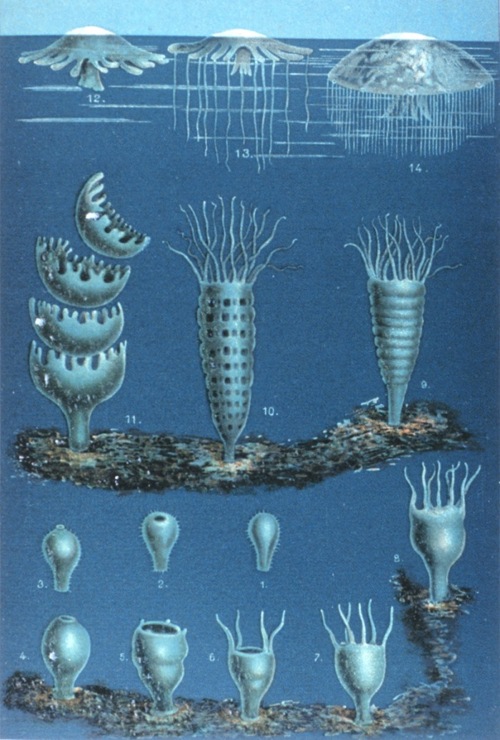
Which, frankly, is deeply cool. This image (found in Wikipedia) showing the life-cycle of the jellyfish is from Das Meer by Matthias Jacob Schleiden. As is this other rather fabulous image:
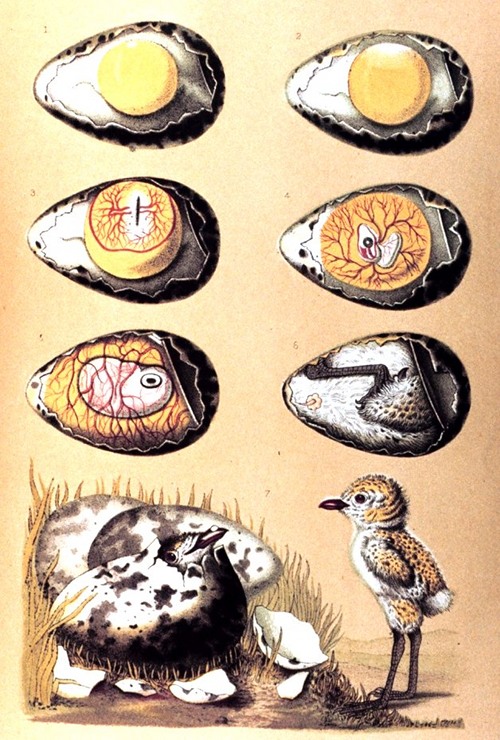
That might be enough random stuff from Wikipedia for one day.
RSPB Big Garden Birdwatch 2009
My list for the RSPB Big Garden Birdwatch:
Blue tit 3
Great tit 2
Long-tailed tit 2
Chaffinch 2
Robin 2
Dunnock 1
Magpie 1
Carrion crow 4
Green woodpecker 1
Town pigeon 4
Woodpigeon 2
Sparrowhawk 1
Which is basically pretty rubbish — it was very quiet today — but is livened up by a couple of decent species: sparrowhawk, which is increasingly common around here but by no means something I see in the garden often, and green woodpecker, which it turns out I have seen once before on a BGBW, but was still pleasing.
Most ridiculous gap on that list: blackbird. I mean, come on. Almost as surprising, no ring-necked parakeet.
Lots of possibles that didn’t show: wren, goldcrest, goldfinch, nuthatch, coal tit, great-spotted woodpecker. The garden has been weirdly short of birds for the past two or three years, though. We used to have lots of starlings: I’ve seen about two this year. Same with greenfinches. There used to be lots more chaffinches. I haven’t seen siskin this year.
I don’t know why this is true, but it’s faintly depressing. Ho-hum.
I know it’s getting slightly late for yearly round-up posts, but hey-ho.
Best Plant
The wildflowers on the cliff-tops in Wales were quite something: gorse, foxgloves, bluebells, red campion, sea campion, thrift, kidney vetch, burnet rose, dodder, spring squill, centaury, ox-eye daisies, cowslips. It really was spectacular. So it’s really just a matter of picking a species. I was actually tempted by bluebell, because although it is a fairly common flower and I see it regularly, it is so lovely and it was great to see it in such large quantities; especially on Skomer, where much of the island was covered by sweeping fields of bluebells or red campion.
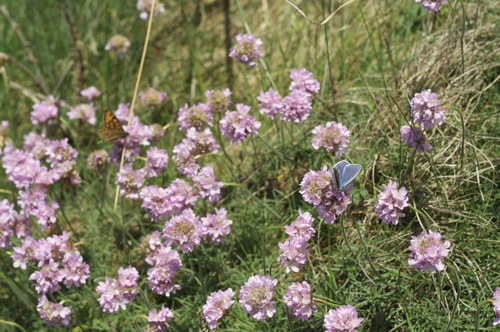
But I thought I’d pick something more typically seasidey, so I think thrift is the obvious choice. That’s a close-up shot above, but it doesn’t give you a sense of the quantities: big cushiony pink piles of it.

Best Insect
Seeing glow-worms was a genuine life-time ambition fulfilled. They’re not as spectacular as some of the species of bioluminescent insect found elsewhere — just a few gentle green glowing dots in the grass on a June evening — but they were still fabulous.
Best Invertebrate (other)
Umm, let me see. I quite enjoyed pottering around looking for rock-pools in Pembrokeshire, though I didn’t find much apart from a few mussels and sea anemones, so let’s go for something I can post a picture of: an unidentified species of red sea-anenome.

Best Fish
It’s hard to think of anything for this one. The best I can come up with is probably the enormous fat brown trout in the Test in Hampshire.
Best Amphibian, Best Reptile
I haven’t been out of the country this year, and that means there are only a total of twelve species that are even possible (three snakes, three lizards, three newts, two toads and a frog), not counting a few breeding populations of introduced species and the occasional vagrant marine turtle. And I didn’t see any of the rarer ones.

But there was one day last June when all the baby frogs apparently decided to leave the pond at once, and the lawn was full of these tiny tiny little froglets. So that was neat. The Flickr set is here.
Best Mammal
I saw a bat hunting for insects in daylight over the lake in the local park at the end of March, so that was a noteworthy sighting. Perhaps it had just emerged from hibernation and was having its first proper meal of the year? I don’t know what kind of date they come out.
But the easy choice for Mammal of the Year was Grey Seal, which breeds in large numbers in Pembrokeshire. It wasn’t seal breeding season when I was there, so they weren’t all over the beach in big numbers and there were no little fluffy white babies, but there were plenty of seals lurking near the islands.
It’s not much of a picture, but just as evidence that I did see at least one seal:
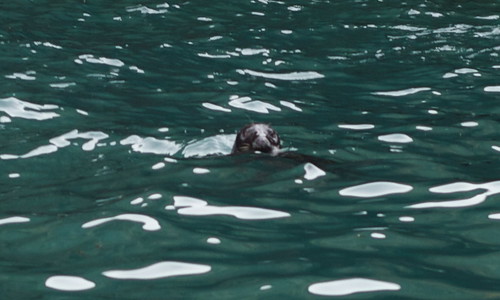
Best Ecosystem
I think you will have seen this coming: I’m going to go for the islands off the coast of Pembrokeshire. Because, you know, seals, shags, choughs, puffins, wild flowers, ravens, peregrine… and most notably, perhaps, the seabird colonies on the cliffs where the guillemots, razorbills and fulmars nest. These weren’t easy to photograph, because they were on cliffs, so you were either peering down from above, or peering up from a boat. Still, this gives you an idea:
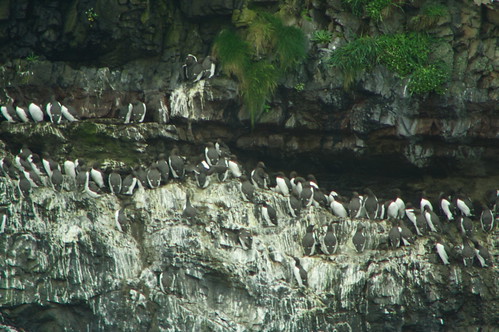
There’s a wider view of some of these cliffs that gives some idea of the scale here, but there’s no point reproducing that photo at 500 pixels wide.
Sitting on a boat and watching a raven come and steal guillemot eggs: how cool is that? The guillemots did try to resist, but the raven just flung them out of the way. It’s not easy being an auk.

Bird of the Year 2008
Nearly all Welsh this year, I think. I’ve seen bugger-all in the garden, and haven’t done that much birding, so it’s mainly down to my spring trip to Pembrokeshire.
Before I get onto that, though, my other notable birdy trip this year was to the WWT reserve at Welney, where they feed the overwintering swans. They weren’t there in the kinds of numbers that they have been sometimes in the past – apparently the whooper swans migrate down through northern Europe and they think because the weather had been mild they were still in Germany or the Netherlands. But they were there, and they are lovely birds which I don’t often see, so that was nice. All the swans in this picture are the wrong species, so you’ll have to take my word for it that there were whooper swans there as well.
So, Pembrokeshire. Lots of the relatively common stuff: sedge warblers, whitethroats, linnets, stonechats, marsh harrier, spotted flycatcher, peregrine. The best bird other than my main target species was garganey, a very attractive little duck and a British tick for me. Oh, and grasshopper warbler deserves a mention, too, especially since I spent so long trying to find the damn thing: it has very distinctive call, a kind of mechanical buzzing, but it lurks.
But the birds I went there for were those of the cliff-tops and offshore islands. The most boring of them were the rock pipits, which are a genuine cliffy speciality but let’s be honest, they have the charisma (and indeed general appearance and personality) of mice. Much more exciting were the choughs [‘chuffs’]. To slip into Shakespeare for a moment:
When they him spy,
As wild geese that the creeping fowler eye,
Or russet-pated choughs, many in sort,
Rising and cawing at the gun’s report,
Sever themselves and madly sweep the sky,
So, at his sight, away his fellows fly
Choughs aren’t actually russet-pated, as such, they have red beaks and legs. Very attractive birds, and they make this great metallic chee-ow noise as they fly around. Here’s my photo, not the best ever, but it gives you the idea:

Chough might be a real contender for bird of the year except that I’ve seen them before, years ago in Morocco.
After that, it’s all sea birds, starting with gulls and the fulmar, a bird which looks superficially like a gull but is actually a tubenose; sort of like a tiny fat albatross. Then there’s the cormorant and its more glamorous cousin the shag (a really gorgeous bird, with an oilgreen tint to its black feathers, a yellow gape and a little Tintin crest). And I took an evening boat trip to see another tubenose: the Manx shearwaters coming in to land. They feed their young at night to avoid predators, so although on the island of Skomer I saw lots of dead ones in various states of disintegration, I didn’t see a single live one. Apparently they make an unholy racket during the night, though.
Confusingly, Manx shearwater has the Latin name Puffinus puffinus, which leads me onto my last set of birds, the auks. Three species, the guillemot, the razorbill, and the puffin.


They are all beautiful species, and it was great to take a boat trip to see the huge colonies on the cliffs with thousands of guillemots and razorbills — and to see a raven stealing guillemot eggs — but the reason I went to Wales and my Bird of the Year 2008 is puffin. Atlantic Puffin, Fratercula arctica, to be exact.
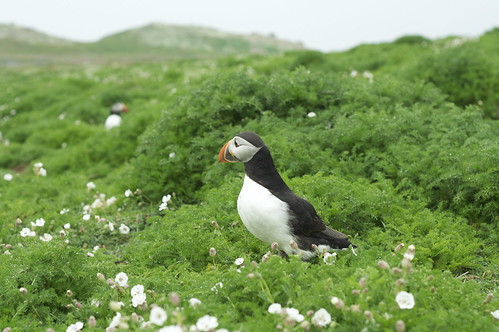
If you feel cold at this time of the year, spare a thought for the puffins, which overwinter out in the middle of the north Atlantic. Brrr.
Darwin and wildlife photography at the NHM
I went along to the Natural History Museum to visit a couple of exhibitions: Wildlife Photographer of the Year and Darwin.

The WPotY exhibition is an annual treat; some years are better than others, but it’s never less than enjoyable. My long-term gripe is that the overall winner is almost always a portrait of a large charismatic mammal (usually one of the African big games species) rather than ever being a picture of a shrimp or a toadstool or something. This year I’m willing to give them a partial credit on that front; they’ve picked a picture of a big cat, but it’s the fabulous, rare and extremely elusive snow leopard, and the picture, a night-time shot with falling snow, is pretty great.
You can see all the pictures online, but they also put the show on in other venues around the UK and around the world, so if South Kensington isn’t convenient you still might be able to see it somewhere near you. The shot above is of a polar bear at sunrise. Cool, innit. And how about this one, of leafcutter ants carrying petals:

The Darwin exhibition, part of the build-up to his 200th birthday next year, takes us through his life and work, and is full of artefacts (notebooks, letters) and specimens he collected. It does a good job of telling us about his life, I think, although as I’ve read two biographies of Darwin, and the Voyage of the Beagle, and The Origin of Species, and a biography of his grandfather, and one of Huxley, most of the material was familiar to me. I did enjoy it — it’s good to see all his scribbly handwriting and there are some great items on show — but none of it was really news to me, so I may not be the key audience.
btw, if you’re going to the museums at South Ken, you could do worse than have lunch at Casa Brindisa. Brindisa are a Spanish food importer with a shop in Borough Market who now have three tapas bars, and the lunch I had in there was just excellent. The website has the menu on it, so I can tell you exactly what I had: the pan fried sea bream with morcilla de Burgos and Bierzo peppers, a herb salad with moscatel vinaigrette and a serving of patatas bravas. It was all really delicious; the fish was crisp and perfectly cooked and went beautifully with earthiness of the morcilla and the slightly spicy peppers; the salad was fresh and herby with just enough slightly sweet dressing, and the potatoes were golden and crunchy without being oily and not drowned in the sauce. They even make an excellent cup of coffee, which is almost harder to find than a good plate of food.
